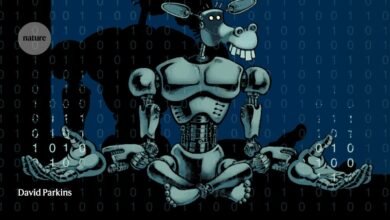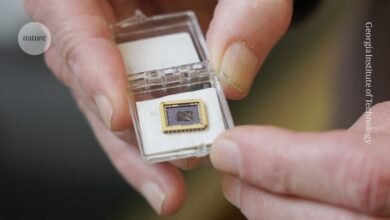Stream–disk shocks as the origins of peak light in tidal disruption events
Hills, J. G. Possible power source of Seyfert galaxies and QSOs. Nature 254, 295–298 (1975).
Rees, M. J. Tidal disruption of stars by black holes of 106–108 solar masses in nearby galaxies. Nature 333, 523–528 (1988).
Komossa, S. & Bade, N. The giant X-ray outbursts in NGC 5905 and IC 3599: follow-up observations and outburst scenarios. Astron. Astrophys. 343, 775–787 (1999).
Gezari, S. et al. Ultraviolet detection of the tidal disruption of a star by a supermassive black hole. Astrophys. J. 653, L25–L28 (2006).
van Velzen, S. et al. Optical discovery of probable stellar tidal disruption flares. Astrophys. J. 741, 73 (2011).
Gezari, S. et al. An ultraviolet-optical flare from the tidal disruption of a helium-rich stellar core. Nature 485, 217–220 (2012).
Arcavi, I. et al. A continuum of H- to He-rich tidal disruption candidates with a preference for E+A galaxies. Astrophys. J. 793, 38 (2014).
Ulmer, A. Flares from the tidal disruption of stars by massive black holes. Astrophys. J. 514, 180–187 (1999).
Piran, T., Svirski, G., Krolik, J., Cheng, R. M. & Shiokawa, H. Disk formation versus disk accretion—what powers tidal disruption events? Astrophys. J. 806, 164 (2015).
Shiokawa, H., Krolik, J. H., Cheng, R. M., Piran, T. & Noble, S. C. General relativistic hydrodynamic simulation of accretion flow from a stellar tidal disruption. Astrophys. J. 804, 85 (2015).
Loeb, A. & Ulmer, A. Optical appearance of the debris of a star disrupted by a massive black hole. Astrophys. J. 489, 573–578 (1997).
Guillochon, J., Manukian, H. & Ramirez-Ruiz, E. PS1-10jh: the disruption of a main-sequence star of near-solar composition. Astrophys. J. 783, 23 (2014).
Coughlin, E. R. & Begelman, M. C. Hyperaccretion during tidal disruption events: weakly bound debris envelopes and jets. Astrophys. J. 781, 82 (2014).
Roth, N., Kasen, D., Guillochon, J. & Ramirez-Ruiz, E. The X-ray through optical fluxes and line strengths of tidal disruption events. Astrophys. J. 827, 3 (2016).
Metzger, B. D. & Stone, N. C. A bright year for tidal disruptions. Mon. Not. R. Astron. Soc. 461, 948–966 (2016).
Roth, N. & Kasen, D. What sets the line profiles in tidal disruption events? Astrophys. J. 855, 54 (2018).
Lodato, G., Cheng, R. M., Bonnerot, C. & Dai, J. L. Simulations of tidal disruption events. Space Sci. Rev. 216, 63 (2020).
Hayasaki, K., Stone, N. & Loeb, A. Finite, intense accretion bursts from tidal disruption of stars on bound orbits. Mon. Not. R. Astron. Soc. 434, 909–924 (2013).
Hayasaki, K., Stone, N. & Loeb, A. Circularization of tidally disrupted stars around spinning supermassive black holes. Mon. Not. R. Astron. Soc. 461, 3760–3780 (2016).
Bonnerot, C., Rossi, E. M., Lodato, G. & Price, D. J. Disc formation from tidal disruptions of stars on eccentric orbits by Schwarzschild black holes. Mon. Not. R. Astron. Soc. 455, 2253–2266 (2016).
Sadowski, A., Tejeda, E., Gafton, E., Rosswog, S. & Abarca, D. Magnetohydrodynamical simulations of a deep tidal disruption in general relativity. Mon. Not. R. Astron. Soc. 458, 4250–4268 (2016).
Bonnerot, C. & Lu, W. Simulating disc formation in tidal disruption events. Mon. Not. R. Astron. Soc. 495, 1374–1391 (2020).
Bonnerot, C., Lu, W. & Hopkins, P. F. First light from tidal disruption events. Mon. Not. R. Astron. Soc. 504, 4885–4905 (2021).
Andalman, Z. L., Liska, M. T. P., Tchekhovskoy, A., Coughlin, E. R. & Stone, N. Tidal disruption discs formed and fed by stream–stream and stream–disc interactions in global GRHD simulations. Mon. Not. R. Astron. Soc. 510, 1627–1648 (2022).
Hung, T. et al. Revisiting optical tidal disruption events with iPTF16axa. Astrophys. J. 842, 29 (2017).
van Velzen, S. et al. Seventeen tidal disruption events from the first half of ZTF survey observations: entering a new era of population studies. Astrophys. J. 908, 4 (2021).
Yalinewich, A., Steinberg, E. & Sari, R. RICH: open-source hydrodynamic simulation on a moving Voronoi mesh. Astrophys. J. Suppl. Ser. 216, 35 (2015).
Sadowski, A. et al. Global simulations of axisymmetric radiative black hole accretion discs in general relativity with a mean-field magnetic dynamo. Mon. Not. R. Astron. Soc. 447, 49–71 (2015).
Stone, N. C. & Metzger, B. D. Rates of stellar tidal disruption as probes of the supermassive black hole mass function. Mon. Not. R. Astron. Soc. 455, 859–883 (2016).
Bricman, K. & Gomboc, A. The prospects of observing tidal disruption events with the large synoptic survey telescope. Astrophys. J. 890, 73 (2020).
Jonker, P. G., Stone, N. C., Generozov, A., van Velzen, S. & Metzger, B. Implications from late-time X-ray detections of optically selected tidal disruption events: state changes, unification, and detection rates. Astrophys. J. 889, 166 (2020).
Ben-Ami, S. et al. The scientific payload of the Ultraviolet Transient Astronomy Satellite (ULTRASAT). In Proc. SPIE, Space Telescopes and Instrumentation 2022: Ultraviolet to Gamma Ray Vol. 12181 (eds den Herder, J.-W. A. et al.) 1218105 (SPIE, 2022).
Lu, W., Kumar, P. & Narayan, R. Stellar disruption events support the existence of the black hole event horizon. Mon. Not. R. Astron. Soc. 468, 910–919 (2017).
Wen, S., Jonker, P. G., Stone, N. C. & Zabludoff, A. I. Mass, spin, and ultralight boson constraints from the intermediate-mass black hole in the tidal disruption event 3XMM J215022.4-055108. Astrophys. J. 918, 46 (2021).
Bade, N., Komossa, S. & Dahlem, M. Detection of an extremely soft X-ray outburst in the HII-like nucleus of NGC 5905. Astron. Astrophys. 309, L35–L38 (1996).
van Velzen, S., Holoien, T. W.-S., Onori, F., Hung, T. & Arcavi, I. Optical-ultraviolet tidal disruption events. Space Sci. Rev. 216, 124 (2020).
Lodato, G., King, A. R. & Pringle, J. E. Stellar disruption by a supermassive black hole: is the light curve really proportional to t−5/3? Mon. Not. R. Astron. Soc. 392, 332–340 (2009).
Gallegos-Garcia, M., Law-Smith, J. & Ramirez-Ruiz, E. Tidal disruptions of main-sequence stars of varying mass and age: inferences from the composition of the fallback material. Astrophys. J. 857, 109 (2018).
Law-Smith, J. A. P., Coulter, D. A., Guillochon, J., Mockler, B. & Ramirez-Ruiz, E. Stellar Tidal Disruption Events with Abundances and Realistic Structures (STARS): library of fallback rates. Astrophys. J. 905, 141 (2020).
Guillochon, J. & Ramirez-Ruiz, E. A dark year for tidal disruption events. Astrophys. J. 809, 166 (2015).
Lu, W. & Bonnerot, C. Self-intersection of the fallback stream in tidal disruption events. Mon. Not. R. Astron. Soc. 492, 686–707 (2020).
Paczyńsky, B. & Wiita, P. J. Thick accretion disks and supercritical luminosities. Astron. Astrophys. 88, 23–31 (1980).
Tomida, K., Okuzumi, S. & Machida, M. N. Radiation magnetohydrodynamic simulations of protostellar collapse: nonideal magnetohydrodynamic effects and early formation of circumstellar disks. Astrophys. J. 801, 117 (2015).
Pejcha, O., Metzger, B. D. & Tomida, K. Cool and luminous transients from mass-losing binary stars. Mon. Not. R. Astron. Soc. 455, 4351–4372 (2016).
Ferland, G. J. et al. The 2017 Release Cloudy. Rev. Mex. Astron. Astrofis. 53, 385–438 (2017).
Krumholz, M. R., Klein, R. I., McKee, C. F. & Bolstad, J. Equations and algorithms for mixed-frame flux-limited diffusion radiation hydrodynamics. Astrophys. J. 667, 626–643 (2007).
Fleck, J. A.Jr & Cummings, J. D. An implicit Monte Carlo scheme for calculating time and frequency dependent nonlinear radiation transport. J. Comput. Phys. 8, 313–342 (1971).
Kochanek, C. S. The aftermath of tidal disruption: the dynamics of thin gas streams. Astrophys. J. 422, 508–520 (1994).
Bonnerot, C. & Stone, N. C. Formation of an accretion flow. Space Sci. Rev. 217, 16 (2021).
Bonnerot, C. & Lu, W. The nozzle shock in tidal disruption events. Mon. Not. R. Astron. Soc. 511, 2147–2169 (2022).
Carter, B. & Luminet, J.-P. Tidal compression of a star by a large black hole. I Mechanical evolution and nuclear energy release by proton capture. Astron. Astrophys. 121, 97–113 (1983).
Stone, N., Sari, R. & Loeb, A. Consequences of strong compression in tidal disruption events. Mon. Not. R. Astron. Soc. 435, 1809–1824 (2013).
Liptai, D., Price, D. J., Mandel, I. & Lodato, G. Disc formation from tidal disruption of stars on eccentric orbits by Kerr black holes using GRSPH. Preprint at https://doi.org/10.48550/arXiv.1910.10154 (2019).
Coughlin, E. R., Nixon, C., Begelman, M. C. & Armitage, P. J. On the structure of tidally disrupted stellar debris streams. Mon. Not. R. Astron. Soc. 459, 3089–3103 (2016).
Hayasaki, K., Bate, M. R. & Loeb, A. Ionization and dissociation induced fragmentation of a tidally disrupted star into planets around a supermassive black hole. Preprint at https://doi.org/10.48550/arXiv.2001.04172 (2020).
Steinberg, E., Coughlin, E. R., Stone, N. C. & Metzger, B. D. Thawing the frozen-in approximation: implications for self-gravity in deeply plunging tidal disruption events. Mon. Not. R. Astron. Soc. 485, L146–L150 (2019).
Kasen, D. & Ramirez-Ruiz, E. Optical transients from the unbound debris of tidal disruption. Astrophys. J. 714, 155–162 (2010).
Dai, L., McKinney, J. C. & Miller, M. C. Soft X-ray temperature tidal disruption events from stars on deep plunging orbits. Astrophys. J. Lett. 812, L39 (2015).
Wegg, C. Pseudo-Newtonian potentials for nearly parabolic orbits. Astrophys. J. 749, 183 (2012).
Dai, L., McKinney, J. C., Roth, N., Ramirez-Ruiz, E. & Miller, M. C. A unified model for tidal disruption events. Astrophys. J. Lett. 859, L20 (2018).
Jiang, Y.-F., Stone, J. M. & Davis, S. W. Super-Eddington accretion disks around supermassive black holes. Astrophys. J. 880, 67 (2019).
Arcavi, I. Errors when constraining hot blackbody parameters with optical photometry. Astrophys. J. 937, 75 (2022).
Mummery, A. & Balbus, S. A. The spectral evolution of disc dominated tidal disruption events. Mon. Not. R. Astron. Soc. 492, 5655–5674 (2020).
Wen, S., Jonker, P. G., Stone, N. C., Zabludoff, A. I. & Psaltis, D. Continuum-fitting the X-ray spectra of tidal disruption events. Astrophys. J. 897, 80 (2020).
Lin, D. et al. A luminous X-ray outburst from an intermediate-mass black hole in an off-centre star cluster. Nat. Astron. 2, 656–661 (2018).
Ramirez-Ruiz, E. & Rosswog, S. The Star Ingesting Luminosity of Intermediate-Mass Black Holes in Globular Clusters. Astrophys. J. 697, L77–L80 (2009).
Curd, B. Global simulations of tidal disruption event disc formation via stream injection in GRRMHD. Mon. Not. R. Astron. Soc. 507, 3207–3227 (2021).
Source link



